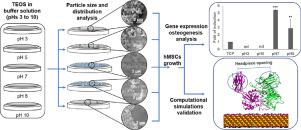Acta Biomaterialia ( IF 9.4 ) Pub Date : 2020-11-04 , DOI: 10.1016/j.actbio.2020.10.043 Zaira Martín-Moldes 1 , Diego López Barreiro 2 , Markus J Buehler 2 , David L Kaplan 3

|
Understanding the properties and behavior of biomineralized protein-based materials at the organic-inorganic interface is critical to optimize the performance of such materials for biomedical applications. To that end, this work investigates biomineralized protein-based films with applications for bone regeneration. These films were generated using a chimeric protein fusing the consensus repeat derived from the spider Nephila clavipes major ampullate dragline silk with the silica-promoting peptide R5 derived from the Cylindrotheca fusiformis silaffin gene. The effect of pH on the size of silica nanoparticles during their biomineralization on silk films was investigated, as well as the potential impact of nanoparticle size on the differentiation of human mesenchymal stem cells (hMSCs) into osteoblasts. To that end, induction of the integrin αV subunit and the osteogenic markers Runx2 transcription factor and Bone Sialoprotein (BSP) was followed. The results indicated that pH values of 7-8 during biomineralization maximized the coverage of the film surface by silica nanoparticles yielding nanoparticles ranging 200-500 nm and showing enhanced osteoinduction in gene expression analysis. Lower (3-5) or high (10) pH values led to lower biomineralization and poor coverage of the protein surfaces, showing reduced osteoinduction. Molecular dynamics simulations confirmed the activation of the integrin αVβ3 in contact with silica nanoparticles, correlating with the experimental data on the induction of osteogenic markers. This work sheds light on the optimal conditions for the development of fit-for-purpose biomaterial designs for bone regeneration, while the agreement between experimental and computational results shows the potential of computational methods to predict the expression of osteogenic markers for biomaterials.
Statement of Significance
The ability of biomineralized materials to induce hMSCs differentiation for bone tissue regeneration applications was analyzed. Biomaterials were created using a recombinant protein formed by the consensus repeat derived from the spider Nephila clavipes major ampullate dragline silk and the silica-promoting peptide R5 derived from the Cylindrotheca fusiformis silaffin gene. A combination of computational and experimental techniques revealed the optimal conditions for the synthesis of biomineralized silk-silica films with enhanced expression of markers related to bone regeneration.
中文翻译:

二氧化硅纳米颗粒尺寸对生物矿化丝-二氧化硅纳米复合材料骨诱导的影响
了解生物矿化蛋白质材料在有机-无机界面上的性质和行为对于优化此类材料在生物医学应用中的性能至关重要。为此,这项工作研究了生物矿化蛋白质基薄膜及其在骨再生中的应用。这些薄膜是使用嵌合蛋白产生的,该嵌合蛋白将源自蜘蛛Nephila clavipes Major ampullate 拖丝的共有重复序列与源自Cylindrotheca fusiformis silaffin 基因的二氧化硅促进肽 R5 融合。研究了二氧化硅纳米颗粒在丝膜上生物矿化过程中 pH 值对其尺寸的影响,以及纳米颗粒尺寸对人间充质干细胞 (hMSC) 分化为成骨细胞的潜在影响。为此,对整合素 αV 亚基、成骨标记物 Runx2 转录因子和骨唾液蛋白 (BSP) 进行诱导。结果表明,生物矿化过程中 7-8 的 pH 值使二氧化硅纳米颗粒对薄膜表面的覆盖最大化,产生 200-500 nm 的纳米颗粒,并在基因表达分析中显示出增强的骨诱导作用。较低 (3-5) 或较高 (10) pH 值会导致生物矿化程度降低和蛋白质表面覆盖率较差,从而显示出骨诱导作用降低。分子动力学模拟证实了整合素 αVβ3 与二氧化硅纳米颗粒接触时的激活,这与诱导成骨标志物的实验数据相关。 这项工作揭示了开发适合骨再生的生物材料设计的最佳条件,而实验和计算结果之间的一致性表明了计算方法预测生物材料成骨标记物表达的潜力。
重要性声明
分析了生物矿化材料诱导 hMSC 分化以用于骨组织再生应用的能力。使用源自蜘蛛Nephila clavipes大壶腹拖丝的共有重复序列和源自Cylindrotheca fusiformis silaffin 基因的二氧化硅促进肽 R5 形成的重组蛋白来创建生物材料。计算和实验技术的结合揭示了合成生物矿化丝二氧化硅膜的最佳条件,并增强了与骨再生相关的标记物的表达。











































 京公网安备 11010802027423号
京公网安备 11010802027423号